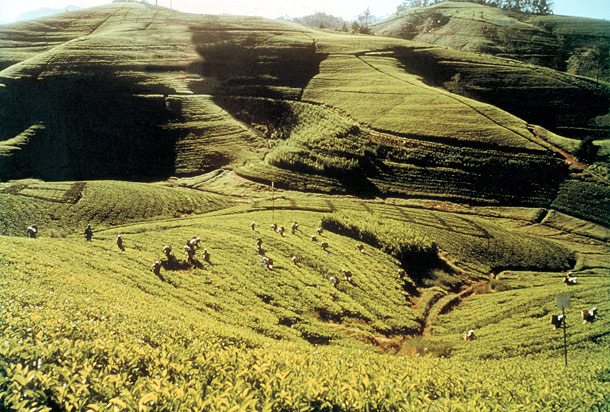Targett

Targett
+91 33 22307241 / 42
Courtesy: THE SAGA OF INDIAN TEA by Prafull Goradia and Kalyan Sircar
Acres after acre, mile upon mile, died out and what were once happy valleys became valleys of dry bones and there was no hope of resurrection”. And out of the despair wrought by Hemeleia vastatrix in south India after it crossed the Palk Straits, having decimated the coffee plantations of Ceylon, there began a search for new livelihood in the wild Western Ghats of south India by those pioneering British who had opened up the rugged wilderness in the 1810s. As coffee plantation after coffee plantation withered and died, planters left surveying the ruins of a life’s work caused by leaf rust — turned in a frenzy of madness to search for non-existent gold. First they turned to cinchona but ultimately they followed a path the pioneering coffee planters had blazed in Ceylon. They turned to tea.

Today, the southern reaches of the Western Ghats, stretching from Nilgiri-Wynaad tri-state junction where Tamil Nadu, Karnataka and Kerala meet the high ranges of Kerala and Tamil Nadu — to the low range of Kerala where the Ghats peter out, are carpeted by tea. The saga of laying that carpet is a fascinating one that ties together several stories.
The first of those stories going back to local folklore is that of the a rough, rugged and thickly-forested land, alive with visions of ghosts, animals, dangerous reptiles and strange birds, a land whose heights no ventured into. These were the mountain ranges that were pushed up when rishi "Parasurama" hurled his sword and cleaved the waters of the Arabian Sea, thereby creating a narrow fertile coastal plain and the protective mountains that prove equally fertile to those who dared. These were the Western C stretching all along the 70-mile wide western coastal plain that lies behind Konkan and Malabar coasts. For the first 500 miles of their 900-mile le the Western Ghats run through Maharashtra and northern Karnataka as hills that only occasionally rise beyond 2500 feet. But south of the Tungab they start rising as well as spreading eastwards as a wide plateau till they the low, rocky outcrop of the Eastern Ghats. These, the highest ranges Western Ghats and its eastern spurs, are the south’s plantation country.
In the north, just south of the Tungabhadra river, are the Baba Budan and north and south Mysore and Coorg — once princely states but now al of Karnataka. Just below Coorg is Kerala Wynaad and stretching east from just north of the Bhavani river, are the Nilgiri Wynaad and the Nilgiris, the high ranges of the Ghats and then the lower Billirangans and the still Shevaroys, where the modern planting industry in the south first began. SIoping into a valley south of the Nilgiris and rising into the Neiliampathies, the W Ghats rise to their highest in the Anamallais (which branch off as another eastern spur that ends up in the Palanis) and the H.igh Ranges, before gently sloping into the central and south Travancore hills and ending in the Agastya Hills.
In the Mysore and Coorg, the Western Ghats rise to 3,000 to 4,000 feet, in the Nilgiris erala from 5,000 to 8,800 feet and in the Anamallais from 4,000 to nearly 9,000 feet. From north to south, coffee, tea, rubber and spices flourish on the western slopes carpet of these hills, in between long stretches of dense primeval jungle.
This plantation country is a far cry from what the pioneers opened up in land, the 19th century. It was almost inaccessible dense jungle and malaria infested wild swamp, which the early planters cleared to establish the first plantations. These man have grown into the giant estates of today. They rode on horseback or sat up in Lord primitive bullock carts; they were carried up in slung chairs and for the most part walked the jungle tracks as they climbed the peaks. They followed the trails that elephants had created over the centuries and the first clearings in forests that were home to the elephant and bison, tiger and leopard, wild boar and wild id the dog and every imaginable kind of reptile. These intrepid men built grass huts to live in, shot sambhar, boar and hare, wild pigeon and jungle fowl for the pot, brought in labour from the plains, then tried to keep them from running away from the cold and the ‘demons’ of the forests! They cleared small patches of each land in this wilderness, planted the first nurseries, raised the first crops and then )f the went on to clear the next block.
Out of the ruin of coffee, tea emerged as a savior in the Anamallais, the High Range, the Nilgiris and Wynaad. But it was a crop that planters in here, south India had long been reluctant to turn to. Tea, in fact, had a long history first of experimental efforts in the Western Ghats preceding the thrust Finlay Muir’s gave it in the Kanan Devan Hills.
The south Indian tea story begins with Assistant Surgeon Christie, who, tern in 1832, ordered some tea plants from China when he noticed that the Camellia, which closely resembles tea, grew well in the Nilgiris.